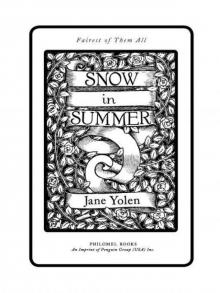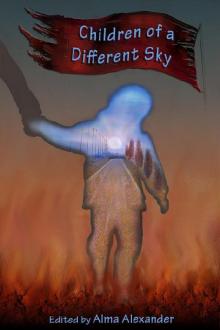- Home
- Jane Yolen
Cards of Grief
Cards of Grief Read online
Cards of Grief
Jane Yolen
For Georgia and Milton and all the cloud-filled skies
ARCHIVIST’S REPORT
HERE ARE THE PRELIMINARY tapes and reports on our one-hundred-year study of Henderson’s IV, known in the common tongue as L’Lal’lor, the Planet of the Grievers.
As with all one-hundred-year studies, the first fifty are done SS (Surreptitious Surveillance), including planet mapping, flora and fauna studies, geologic probes, infrared night photography. Whenever there is a viable intelligence within the native populations, we also implant long-lived voice-activated recorders randomly which aid in the study of language and culture.
The second fifty years consist of open visits by anthropologists, linguists, historians, but always AD (Arm’s Distance). We are observers only. We try not to influence the history of a planet or contaminate a living culture, but occasionally—as in the contact with the inhabitants of Henderson’s IV—mistakes are made.
In this particular study, it is essential to keep in mind that life aboard the space lab accounts for one year per ten on planetfall due to the Hulanlocke Rotational Device, so that this one-hundred-year study took ten years subjective or labtime.
These preliminary tapes are not arranged chronologically but in a manner that will allow the listener to understand the nature of the culture contamination.
Planetfall: Henderson’s IV is a water planet with only one major continental land mass.
Species contacted: “High intelligence life forms; humanoid; two distinct morphs; two distinct sexes.
Society: Clan format; six great endomorphic families representing general labor groups ruled by seventh which is ectomorphic and near barren; matriarchal descent pattern; blocked technology at approximately Bronze; high artistic levels.
Biology, Geology: Reports to come.
Histo-Archeologist’s Synoptic: There is strong geologic evidence of a catastrophic flood having covered the face of the planet within the last millennium, said evidence supported by oral tradition of the master singers and poets. Said flood left only the highest mountains untouched. (See work entitled Shells in Strata, sub. 4 Geologist’s Report.) Those mountaintops are honeycombed with enormous caves that lead into unlit fuliginous-sided caverns filled with fossilized tree residue, evidence of hearthfires. The surrounding valleys retain humanoid bones in a scattered pattern suggesting exposure rather than burial as the prime manner of disposing of the dead. Modern L’Lal’lorians, with their cat’s eyes and fine night sight, with their culture emphasis on caves as a place of dying but not of burial, are a logical consequence both physically and culturally of a cave-dwelling past.
The matriarchal system is an outgrowth of the small live-birth ratio and early infant death syndrome, i.e., females, the bearers, are highly valued. Since the flood at least, only a small section of land has been salvaged from—or given up by—the sea; the population has grown only enough to comfortably fill the island continent. The people are in-bred, the resultant culture homogenous. The only thing that keeps the breed as hardy as it is is the custom of polyandry and of sending the nearly sterile male Royals on a long coming-of-age journey, ostensibly for gaining cultural perspective. In fact it encourages a mixing of the small gene pool and the occasional resultant ectomorphs are nearly always the most talented and intelligent of their groups, taking on leadership roles easily.
Anthropologist’s Synoptic: This grief-centered culture is not to be confused with the death-centered societies such as those found on Atropos or Maytec or our own early Egyptian. Rather the L’Lal’lorians revere life and do not fear death, though they live life in a kind of gray haze, without laughter or passion. Still, there is no war nor any racial memory of large conflicts, no infanticide, little murder except where ordered by the ruler, no theft. There is, however, a form of suicide widely practiced by the older L’Lal’lorians as an escape from any wasting terminal illnesses. It is ritualized, painless, and quick. Confession before such a death is important and the choice of the confessor not often left to chance.
The grieving, which is as much art as religion, is the L’Lal’lorian way of remembering, an artistic bid for continuity, for they believe in no substantial afterlife and there is no evidence whatsoever of a belief in reincarnation. Unlike our own seventeenth-century poet Thomas Carew who wrote, “Grief is a puddle and reflects not cleare,” grieving for the L’Lal’lorians is a clear reflection of their societal needs and a recording of their prehistory in caves. And while at first glance it may seem no more than a parody of Earth customs such as tomb decoration (N.B. Falkowitz’s essay on Italian grave decor, The Journal of the Folklore Society, 1997:2) or a trade show (N.B. Morrissey-White “A Study in the Ad Biz,” Harvard Press Monographic Series 2037), this planet is an untouched humanoid society and we have been First Contact. The customs are their own.
To observe, to study, to learn: those are the words of the Anthropologist’s Guild.
Note****Note****Note**** Culture Contact Contamination by Anthropologist First Class Aaron Spenser, B.S., M.S., Ph.D., Star Certificate 9876433680K. Court Martial records herewith. Sentence five years space lab, equal to fifty years on-planet. In his favor, Anthropologist First Class Spenser’s work on the culture of Henderson’s IV has been invaluable and while he has since GN (gone native), it is included in the Synoptic and elsewhere.
Enclosed prelim tapes and studies
Tape 1: The Seven Grievers, Part I
Tape 2: In the Hall of Grief
Tape 3: The Singer of Dirges
Tape 4: The Seven Grievers, Part II
Tape 5: Prince of Traitors
Tape 6: The Seven Grievers, Part III
Tape 7: Betrayals
Tape 8: The Man Without Tears (Court Martial)
Tape 9: Queen of Shadows
Tape 10: Child of Earth and Sky
Tape 11: Transmission to Command
Tape 12: Cards of Grief
A Note from the Author
A Biography of Jane Yolen
Tape 1: THE SEVEN GRIEVERS, PART I
Place: Queen’s Hall of Grief, Room of Instruction
Time: Queen’s Time 23, Thirteenth Matriarchy; labtime 2132.5+ A.D.
Speaker: Queen’s Own Griever to the apprentices, including Lina-Lania
Permission: No permission, preset, voice-activated
THIS IS THE SONG of the Seven Grievers, the seven great families of L’Lal’lor, from the days and nights of the sky’s grieving to the very moment of my tongue’s speaking. I have held these dolorous chants in my mind and in my heart against the time when, as the Queen’s Own Griever, I may have to wail for the wasting of our land once again.
The first time our land died it was in water; but of water we may speak only at birth when water gushes forth unbidden from the cave of the womb, or at grieving when the waters flow at our bidding from our sorrowing eyes.
The next time the land dies, say the prophesies, will be when we forget to grieve.
It is written in the sky; it is written in the rocks; it is written in the sea; it is written on our hearts. But nowhere is it to be written down in any scripting of our own devising, for such is forbidden lest we then forget how to read it. To hold in the mouth is to remember; to set down is to forget. This sacred knowledge, therefore, must be passed Griever to Griever, Master to Master, mouth to ear, down through all time.
Hear then, listen well. My word is firm, firmer than sleep or the Cup that carries it, firmer than the strength of heroes. My voice makes the telling true. To listen, to remember, is to know.
Before the weeping of the sky, the land was soft and plentiful and there was no grief. Light bathed the land always and there was no division between the day and the night, between the bright and the dark. S
o there was no cold, no hunger, no hurt, and no dying. The world was called L’Lal’ladia, the Place of Blessing and Rejoicing.
But the People grew tired of such beauty and constant light. They turned to the dark of the caves and to games of chance. They pricked blood from their own arms to count the flow. And so the very skies began to weep blood. For one hundred times one hundred days water fell from the cloudless sky, first red and then clear, until the bowl of the world was filled with it. And all but two who dwelled in L’Lal’ladia and were called the People were drowned. Those two were a man and a woman, and he past the years of seeding. Even the light itself was put out, like a candle between wet fingers, leaving but a gray sooty smudge in the sky.
Then there crept from the caves in the highest mountains a second people called Night-Seers who lit watchfires in the day that lifted smoke into the now darkening sky. They sang their heavy songs and they called to the blackness and there was no rejoicing in their hearts. And for one hundred times one hundred nights the world turned black and was lit only by the softly falling stars.
The one arose from the Night-Seers and said, “Let us cast down great stones into the water that we may frighten it back from the land.”
So one by one they rolled down great stones until the water was thrust back, leaving a land that was black as night and rich with the meat of fish and covered with strange bones.
And the smell of that land was strong and hunger called down a few of the Night-Seers onto the plains where they went about, back and forth, through the mud and left the marks of their feet and the prints of their hands as if carved deep into stone. And these few took up their lives on the muddy flats.
And a few of the Night-Seers were called on farther by the salt smell of the sea and followed the receding water to the place where sea and land met and wrestled for the ruling. Here the few Night-Seers stopped and cast their nets far into the water and pulled in their livings from the sea.
But the rest of the Night-Seers still hid in the shadows of the mountains, for they swore they knew the hilly wastes best and there they lived forever.
So the first of the Seven Grievers were these:
Lands, who live on the plains, stockmen and farmers, harrowers and pigkeepers, tillers of soil and grinders of grain.
Waters, who dwell by the sea and harvest with cunningly wrought nets the little finny creatures that swim close to shore.
Rocks, who live in the shadow of the mountains and carve out the face of the stone, crafting jewels and gems, and building blocks.
But from the time of the hundred times a hundred days and the hundred times a hundred nights, and in memory of the time the sky itself wept first blood and then rain, grieving has been the way of remembering and the one great art of our world. And the world is no longer called L’Lal’ladia, the Place of Blessing and Rejoicing’; but is called L’Lal’loria, the Place of the Grievers.
Selah.
Tape 2: IN THE HALL OF GRIEF
Place: Cave #27
Time: King’s Time 1, First Patriarchy; labtime 2137.5+ A.D.
Speaker: Lina-Lania, known as the Gray Wanderer, to her apprentice Grenna
Permission: None, preset, voice-activated
I WAS THIRTEEN SUMMERS, the last turning of childhood, when Great-grandmother became ill. She was exiled upstairs to the windowless room under the thatch to practice lying in darkness. So it is with the very old whose lives are spent in dusk, just as newborns must learn to live in the dawn.
It was not Great-grandmother’s illness that made me eligible to enter the Hall of Grief but my own signs of adulthood: the small breasts just beginning to bud, the fine curlings of hair in the cave places of my body, the rush of fresh blood from the untested nest of my womb.
I was ready. Had I not spent many childhood hours playing at the Hall game? Alone or with my brothers I had built our own Halls of willow branch and mallo snappings. We had set the tables, made signs, drawn pictures. Always, always my table was best, though I was not the oldest of us all. My table had more than just an innocent beauty, decked in ribbons and bordered by wildflowers: red trillis for life, blue-black mourning berries for death, and the twining of green boughs for the passage between. No, my table had a character that was both mine and the grieven one’s. It had substance and imagination and daring, even from the time I was quite young. Everyone remarked on it. The other children sensed it and a few resented it. But the elders who came and watched us at our play, they knew for sure. I heard one say, “She has a gift for grief, that one. Mark her well.” As if my height and the angularity of my body had not marked me already.
But even before that I had known. As a child I had started crafting my own grief poems, childishly lisping them to my dolls. The first poems aped the dirges and threnodies I had been taught, but always with a little twist of my own. One in particular I remember, for my mother shared it with the elders as a sign of my gift. My grandmother argued against that poem and for another, but this quarrel my mother won. The poem began:
I sail out on my dark ship
Toward the unmarked shore
With only the grieving
Of my family to guide me.”
The ship breasts the waves…
The dark ship, the unmarked shore—they were but copies of the usual metaphors of grief. But the wording of the fifth line, the penta—which foreshadowed the central image, that of a carved figurehead of a nude woman, something of which I should have had no knowledge, for we were a people of the Middle Lands, tillers of soil and grinders of grain—that fifth line convinced them. I, the daughter of a miller, gangly and stalk-legged, I was a prodigy. I basked in their praises for weeks and tried to repeat my success, but that time I could not. My subsequent poems were banal; they showed no promise at all. It was years before I realized that, truly, I grieved best when trying for no effect at all, though the critics and the public and the silly men at court did not always know the difference. But the craftswoman knows.
And then the day came when I was old enough to enter the Hall of Grief. I rose early and spent many minutes in front of the glass, the only one in our house not then covered with the gray mourning cloth. I drew dark circles under my eyes and deep shades on my lids as befitted a griever. Of course I overdid it. What new griever does not? I had yet to learn that true grief makes its own hollows in the face, a better sculptor of the body’s contours than all our paints and pens. Artifice should only heighten. But I was young, as I have said, and even Great-grandmother in her dusky room was not enough to teach me then.
That first day I tried something daring. Even that first day my gift for invention showed. I painted my nails the color of my eyelids and, on the left hand, on the thumb, I took a penknife and scraped the paint on the thumbnail into a cross to signify the bisecting of life and death.
Yes, I see you understand. It was the beginning of the carvings I would later do on all my nails, the carvings that would become such a passion among young grievers at court and be given my name. I never do it myself anymore. It seemed such a little thing, then: some extra paint, an extra dab of darkness onto light. An instinctual gesture that others took—mistook—for genius. That is, after all, what genius is: a label for instinct.
I plaited my long hair with trillis and mourning berry, too. And that was much less successful. As I recall, the trillis died before half a day was over and the berries left my braids sticky with juice. Yet at the moment of leavetaking, when I went upstairs to give Great-grandmother the respect I owed her, I felt the proper griever.
She turned in her bed, the one with the carvings of wreaths on the posters, the one in which all the women of our house have died. The air in the room was close and still. Even I had trouble breathing. Then Great-grandmother looked at me with her luminous half-dead eyes, the signs of pain beginning to stretch her mouth wide. She was ill with something that gnawed inside her.
“You will make them remember me?” she asked.
Knowing my mother and grandmother
must have already made the same promise before they left, I nevertheless replied, “Great-grandmother, I will.”
“May your lines of grieving be long,” she said.
“May your time of dying be short,” I answered, and the ritual was complete.
I left at once, not even checking to see if the Cup on the table by the bed was filled. I was far more interested in the Hall of Grief and my part in it than in my Great-grandmother’s actual time of death, when the breath leaps from the wide mouth in an upward sigh. That is, after all, a private moment and grieving is a public act. At thirteen I longed to show my grief in public and win the applause and my Great-grandmother’s immortality. I know now that all our mourning, all our grieving, all the outward signs of our rituals are nothing compared to that one quick moment of release. Do I startle you with my heresy? Ah, child, heresy is the prerogative of old age.
I did not look back at the dark room, but ran down the stairs and into the welcoming light. My mother and her mother had already gone to the Hall. I marched there to the slow metronome of the funerary drums, which cousins of my cousins were always trained to play, but my heart skipped before.
The Hall was even larger than I had dreamed. Great massive pillars with fluted columns and carved capitols held up the roof. I had seen the building from afar—for who had not; it dominated our small town square. But I had never been allowed close enough to really distinguish the carvings. They were appropriate to a Hall, weeping women with their long hair caught up in fanciful waterfalls. You laugh. Only in the countryside could such banal motifs still be seen. It was a very minor Hall to be sure, but to my eyes then it was magnificent, each marble weeper a monument to grief. I drank it all in, eager to be part.
I told the guard at the gate my name and clan and he sent a runner in. My mother appeared shortly and spoke in quiet undertones to the gatekeeper, assuring him that it was my time. He let me in with a brief smile that slit open between the parenthesis of his mustache.

 The Pictish Child
The Pictish Child Cards of Grief
Cards of Grief A Plague of Unicorns
A Plague of Unicorns Heart's Blood
Heart's Blood Mapping the Bones
Mapping the Bones Snow in Summer
Snow in Summer Merlin's Booke: Stories of the Great Wizard
Merlin's Booke: Stories of the Great Wizard Centaur Rising
Centaur Rising The One-Armed Queen
The One-Armed Queen Dragon's Blood
Dragon's Blood Boots and the Seven Leaguers
Boots and the Seven Leaguers The Girl Who Cried Flowers and Other Tales
The Girl Who Cried Flowers and Other Tales The Wizard of Washington Square
The Wizard of Washington Square Tales of Wonder
Tales of Wonder The Emerald Circus
The Emerald Circus Sister Light, Sister Dark
Sister Light, Sister Dark Twelve Impossible Things Before Breakfast
Twelve Impossible Things Before Breakfast The Devil's Arithmetic
The Devil's Arithmetic Trash Mountain
Trash Mountain The Dragon's Boy
The Dragon's Boy A Sending of Dragons
A Sending of Dragons The Young Merlin Trilogy
The Young Merlin Trilogy The Last Tsar's Dragons
The Last Tsar's Dragons Curse of the Thirteenth Fey: The True Tale of Sleeping Beauty
Curse of the Thirteenth Fey: The True Tale of Sleeping Beauty The Bagpiper's Ghost
The Bagpiper's Ghost Nebula Awards Showcase 2018
Nebula Awards Showcase 2018 Hobby
Hobby How to Fracture a Fairy Tale: 2
How to Fracture a Fairy Tale: 2 Children of a Different Sky
Children of a Different Sky Commander Toad and the Intergalactic Spy
Commander Toad and the Intergalactic Spy Wizard’s Hall
Wizard’s Hall The Transfigured Hart
The Transfigured Hart Dragonfield: And Other Stories
Dragonfield: And Other Stories The Magic Three of Solatia
The Magic Three of Solatia The Great Alta Saga Omnibus
The Great Alta Saga Omnibus Favorite Folktales From Around the World
Favorite Folktales From Around the World Passager
Passager The Wizard's Map
The Wizard's Map The Last Changeling
The Last Changeling Except the Queen
Except the Queen Snow in Summer: Fairest of Them All: Fairest of Them All
Snow in Summer: Fairest of Them All: Fairest of Them All The Midnight Circus
The Midnight Circus Atalanta and the Arcadian Beast
Atalanta and the Arcadian Beast Finding Baba Yaga
Finding Baba Yaga The Rogues
The Rogues Dragon's Boy
Dragon's Boy The Hostage Prince
The Hostage Prince Wizard of Washington Square
Wizard of Washington Square How to Fracture a Fairy Tale
How to Fracture a Fairy Tale Magic Three of Solatia
Magic Three of Solatia Curse of the Thirteenth Fey
Curse of the Thirteenth Fey My Brothers' Flying Machine
My Brothers' Flying Machine Not One Damsel in Distress
Not One Damsel in Distress Merlin's Booke
Merlin's Booke Pay the Piper: A Rock 'n' Roll Fairy Tale
Pay the Piper: A Rock 'n' Roll Fairy Tale Merlin
Merlin Troll Bridge
Troll Bridge Pay the Piper
Pay the Piper Dragonfield
Dragonfield Sister Emily's Lightship
Sister Emily's Lightship Hippolyta and the Curse of the Amazons
Hippolyta and the Curse of the Amazons Prince Across the Water
Prince Across the Water Dragon's Heart
Dragon's Heart The Seelie King's War
The Seelie King's War Among Angels
Among Angels Queen's Own Fool
Queen's Own Fool